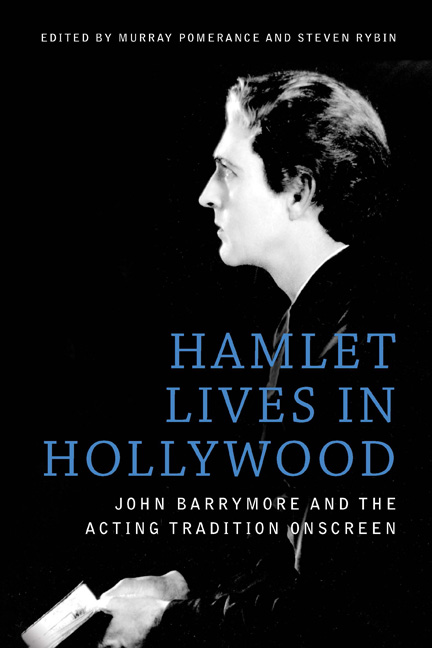Book contents
- Frontmatter
- Contents
- List of Figures
- The Contributors
- Acknowledgments
- Introduction
- 1 The Pre-Bard Stage Career of John Barrymore
- 2 Dangerously Modern: Shakespeare, Voice, and the “New Psychology” in John Barrymore's “Unstable” Characters
- 3 The Curious Case of Sherlock Holmes
- 4 John Barrymore's Introspective Performance in Beau Brummel
- 5 “Keep Back your Pity”: The Wounded Barrymore of The Sea Beast and Moby Dick
- 6 From Rome to Berlin: Barrymore as Romantic Lover
- 7 The Power of Stillness: John Barrymore's Performance in Svengali
- 8 Prospero Unbound: John Barrymore's Theatrical Transformations of Cinema Reality
- 9 A Star is Dead: Barrymore's Anti-Christian Metaperformance
- 10 Handling Time: The Passing of Tradition in A Bill of Divorcement
- 11 John Barrymore's Sparkling Topaze
- 12 “Planes, Motors, Schedules”: Night Flight and the Modernity of John Barrymore
- 13 Barrymore and the Scene of Acting: Gesture, Speech, and the Repression of Cinematic Performance
- 14 “I Never Thought I Should Sink So Low as to Become an Actor”: John Barrymore in Twentieth Century
- 15 Barrymore Does Barrymore: The Performing Self Triumphant in The Great Profile
- Works Cited
- Index
4 - John Barrymore's Introspective Performance in Beau Brummel
Published online by Cambridge University Press: 23 June 2018
- Frontmatter
- Contents
- List of Figures
- The Contributors
- Acknowledgments
- Introduction
- 1 The Pre-Bard Stage Career of John Barrymore
- 2 Dangerously Modern: Shakespeare, Voice, and the “New Psychology” in John Barrymore's “Unstable” Characters
- 3 The Curious Case of Sherlock Holmes
- 4 John Barrymore's Introspective Performance in Beau Brummel
- 5 “Keep Back your Pity”: The Wounded Barrymore of The Sea Beast and Moby Dick
- 6 From Rome to Berlin: Barrymore as Romantic Lover
- 7 The Power of Stillness: John Barrymore's Performance in Svengali
- 8 Prospero Unbound: John Barrymore's Theatrical Transformations of Cinema Reality
- 9 A Star is Dead: Barrymore's Anti-Christian Metaperformance
- 10 Handling Time: The Passing of Tradition in A Bill of Divorcement
- 11 John Barrymore's Sparkling Topaze
- 12 “Planes, Motors, Schedules”: Night Flight and the Modernity of John Barrymore
- 13 Barrymore and the Scene of Acting: Gesture, Speech, and the Repression of Cinematic Performance
- 14 “I Never Thought I Should Sink So Low as to Become an Actor”: John Barrymore in Twentieth Century
- 15 Barrymore Does Barrymore: The Performing Self Triumphant in The Great Profile
- Works Cited
- Index
Summary
In her essay “The Great Profile: How Do We Know the Actor from the Acting?” Marian Keane analyzes a scene in Harry Beaumont's Beau Brummel (1924) in which John Barrymore performs before a full-length mirror, employing a set of gestures to announce “his thought and the fact of his thinking” (187). This is the moment that Barrymore's character George Brummel practices his poses and gestures in order to acquire a more charming and elegant persona which, in turn, marks the beginnings of his public persona: that is, his “Beau” identity.
Gazing at his reflection, Barrymore realizes he can make anything of his appearance. Part of him is always on display, while part of him, his inner self, remains concealed. He gazes here upon his reflection with eyes of an author or a creator, or an actor, who examines the unmolded stuff of a character. (Keane 193)
Here Keane describes not Brummel's realization that he can make anything of his appearance but rather Barrymore's. This (perhaps unintentional) slippage between character and actor/star suggests that the image of Barrymore and the character of Brummel are fused here (that is, Brummel is Barrymore and Barrymore is Brummel). It suggests further that, in this instance, Barrymore was able to disclose to his audience the processes of image-making central to stardom: namely, the revelation of some parts of his self and the concealment of others, as well as the transformation of a personality into a persona capable of circulating publicly to enhance the value of the actor. It is the way in whichBeau Brummel provided John Barrymore with an opportunity both to reflect upon and disclose to his audience some key aspects of image-making and star construction that I shall pursue here, building chiefly upon Marian Keane's work as well as Gaylyn Studlar's chapter on Barrymore in her book This Mad Masquerade: Stardom and Masculinity in the Jazz Age. I shall also consider how Beau Brummel functioned as the perfect star vehicle for Barrymore in 1924, capitalizing on his fame and achievements at that time. Furthermore, taking my cue from Keane, I shall explore more precisely what John Barrymore appears to be thinking during a critical moment of introspection.
- Type
- Chapter
- Information
- Hamlet Lives in HollywoodJohn Barrymore and the Acting Tradition Onscreen, pp. 47 - 58Publisher: Edinburgh University PressPrint publication year: 2017



